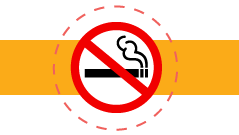Key points
- Commercial tobacco use is the leading US cause of preventable disease, disability, and death. Some groups are affected more than others.
- Using evidence-based strategies can reduce tobacco use and eliminate exposure to secondhand smoke.
- State and local organizations can adopt or strengthen tobacco prevention and control policies.

Background

Commercial tobacco use is the leading cause of preventable disease, disability, and death in the United States. Despite progress in reducing cigarette smoking and related diseases in the past few decades, these reductions have not benefited populations equally. For decades, tobacco companies have used promotions, targeted marketing, and other tactics to unfairly increase access to and appeal of tobacco products for certain groups. Those groups include young people, people who live in low-income communities, and people who are African American or Black, Hispanic or Latino, American Indian and Alaska Native, Asian, or LGBTQ+.
In addition, discrimination, poverty, and other social conditions, such as adverse childhood experiences, are linked to tobacco product use and can make it harder to quit. Tobacco use is also linked to high levels of disease, disability, and death in some populations, such as people with mental health and substance use disorders.
Putting evidence-based strategies into action can prevent young people from using tobacco products, help people quit using tobacco products, eliminate exposure to secondhand smoke, and advance health equity by eliminating tobacco-related disparities. Addressing social determinants of health, including those related to targeted marketing and healthcare access, can move communities toward health equity and reduce health disparities.
Activities for secondhand smoke/tobacco-free policies
- Educate community leaders and other decision makers about the harms of secondhand smoke and the benefits of smokefree/tobacco-free policies.*
- Educate community members about the harms of secondhand smoke exposure and the benefits of smokefree policies.*
- Increase the number and reach of tobacco-free policies in K–12 schools, colleges, and universities.+
- Increase the number and reach of comprehensive smokefree policies in workplaces, restaurants, bars, and casinos.+
- Increase the number and reach of comprehensive smokefree policies in multi-unit housing, such as apartment buildings and condominiums.+
- Increase the number and reach of tobacco-free policies in behavioral health facilities.+
- Ensure smokefree policies are linked to increased access to, and promotion of, cessation services.
Activities for tobacco cessation
- Increase evidence-based health communication interventions to reach groups affected by tobacco-related disparities using culturally and linguistically appropriate protocols, channels, and cessation messages.*
- Implement tailored and/or culturally appropriate, evidence-based, mass-media health communications campaigns that feature people who experience tobacco-related disparities, including campaigns like CDC's Tips From Former Smokers®.*
- Increase the number and reach of private and public insurers and employers that offer barrier-free coverage of Food and Drug Administration-approved cessation medicines and behavioral counseling.+
- Expand clinical screening and treatment for all patients who use tobacco products in all health care settings, including rural health clinics, Federally Qualified Health Centers, Urban Indian Health Centers, integrated health systems, and behavioral health centers.+
Activities for point-of-sale
- Educate community leaders and decision-makers about the link between location, number, and density of tobacco retail outlets and tobacco-related health disparities.*
- Educate community members about the link between location, number, and density of tobacco retail outlets and tobacco-related health disparities.*
- Increase local policies that reduce access to tobacco products, including those that relate to retailer licensure, availability, pricing and promotion, minimum legal sales age, and bans on menthol and other tobacco flavors.+

Working together
Extinguishing the Tobacco Epidemic in California
In 2016, California enacted multiple tobacco control laws as part of a special legislative session. The new laws closed loopholes in the state's smoke-free law, making hotel lobbies, small businesses, and break rooms smoke-free. The law also defined e-cigarettes as a tobacco product, prohibited vaping wherever smoking is also not allowed, required all K–12 public schools to be tobacco-free, raised tobacco retail licensure fees, and increased the legal age of sale of tobacco from 18 to 21.
Extinguishing the Tobacco Epidemic in Massachusetts
Since two tobacco-free pharmacy policies in Massachusetts were adopted in 2009, at least 146 jurisdictions in the state followed suit, making Massachusetts a national leader on this issue.
Extinguishing the Tobacco Epidemic in Michigan
Currently, 25 colleges and universities in Michigan have adopted tobacco-free campus policies voluntarily, and 77 of 124 public housing authorities have adopted policies making housing units smoke-free.
Extinguishing the Tobacco Epidemic in Oklahoma
Less than 6 months after Oklahoma integrated cessation treatments into routine care for Medicaid patients, use of the benefit increased by about 50%. They also succeeded in eliminating copayments for FDA-approved cessation medicines, a major barrier for Medicaid beneficiaries who smoke.
Reducing Retailer Density in Philadelphia
In 2016, Philadelphia, Pennsylvania, capped the total number of tobacco retailer permits and restricted new retailers from being located within 500 feet of schools.
Resources
Addressing Tobacco-Related Health Inequities
Resources to inform point-of-sale policies.
Best Practices for Comprehensive Tobacco Control Programs: 2014
Evidence-based guide to help states build and maintain effective tobacco control programs to prevent and reduce tobacco use.
Best Practices User Guides: Health Equity in Tobacco Prevention and Control
How to identify gaps in health equity and work toward achieving health equity in tobacco control when planning and implementing policies, programs, and interventions.
CDC's National Networks
Consortium of national organizations to advance the prevention of commercial tobacco use and cancer in populations experiencing tobacco- and cancer-related health disparities. Includes links to funded national organizations.
Commercial Tobacco Control: Countering the Tobacco Epidemic
The most effective legal and policy measures that health leaders and policy makers can use to address policies, systems, and environmental changes at the local level, including smokefree air and multi-unit housing, point-of-sale policies, and other key topics.
E-Cigarette Use Among Youth and Young Adults: A Report of the Surgeon General (Executive Summary)
First report issued by a federal agency to comprehensively review the public health issue of electronic cigarettes and their impact on our nation's young people.
Media Campaign Resource Center
Free and low-cost campaign materials to educate audiences about the harmful effects of commercial tobacco use.
Smoking Cessation: A Report of the Surgeon General
Emphasizes that one of the most important actions people can take to improve their health is to quit smoking. Also highlights the latest scientific evidence on the health benefits of quitting smoking, as well as proven treatments and strategies to help people successfully quit smoking.
Tips From Former Smokers®
National tobacco education campaign that uses approaches to address health disparities in pursuit of health equity. Profiles real people from many different backgrounds living with serious long-term health effects from smoking and secondhand smoke exposure.
State Tobacco Activities Tracking and Evaluation (STATE) System
Interactive application that presents current and historical state data on tobacco use prevention and control.
Tobacco Control Network (TCN) Member Directory
State and territorial representatives as well as staff contacts, web and social media links, and seminal documents for the tobacco control agencies that are funded by CDC's Office on Smoking and Health in each state and territory.
Tobacco-Use Prevention and Control – NACCHO
Resources for local health departments to reduce tobacco use and exposure to secondhand smoke in their communities. Includes the 2022 Report that applies CDC's best practices recommendations to specific needs and realities of local tobacco control programs.
Tobacco Where You Live: Retail Strategies to Promote Health Equity
Information on how retail strategies can reduce commercial tobacco use and promote health equity.
Cross-cutting areas
Communication tips to support program efforts.
Evaluation framework for making evaluations useful, feasible, ethical, accurate, and culturally responsive.
Health equity tools to help remove barriers to health.
Additional priority strategies
Breastfeeding Continuity of Care
Increasing Physical Activity Through Community Design
Early Care and Education (ECE) Policies and Activities
Family Healthy Weight Programs
Food Service and Nutrition Guidelines
